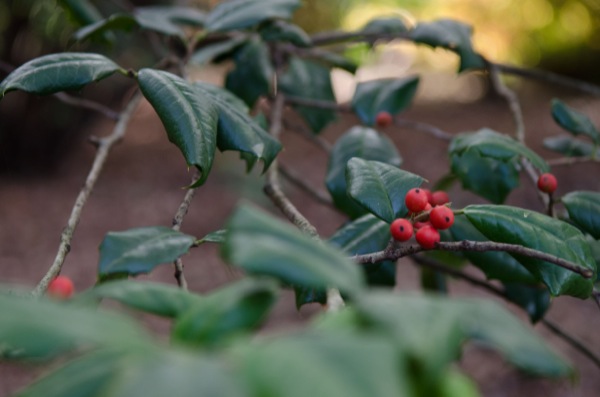
Native Delaware: Holly
Holiday time means American holly, Delaware's state tree
3:10 p.m., Nov. 28, 2012--Shirley Duffy is a recent transplant to Delaware who is proud of her new state. And as an avid gardener, she knew just the way to show her state pride -- by planting an American holly in her Newark yard.
The American holly (Ilex opaca) has been the state tree of Delaware since 1939. Back then, the holly was an important cash crop to the state, says Carrie Murphy, a horticulture agent with University of Delaware Cooperative Extension.
Campus Stories
From graduates, faculty
Doctoral hooding
Holly grew in abundance in the wild, particularly in Sussex County. Savvy entrepreneurs, such as Milton fertilizer salesman Charles C. Jones Sr. recognized that there was money to be made from this broadleaf evergreen. He began shipping wreaths and other holly products throughout the U.S. and abroad. By the 1930s, Delaware had become the leading supplier of holly in the nation. The town of Milton produced more holly wreaths and decorations than any other town in the world.
With the advent of artificial decorations, as well as wage law requirements for piecework businesses, the state’s commercial holly industry declined and ceased entirely by the 1960s. These days, the only holly harvesting in Delaware is in backyards like Duffy’s. A UD Master Gardener, Duffy likes to take holly cuttings throughout the winter, not just at Christmas time.
“I use holly for both indoor and outdoor arrangements,” says Duffy. For an easy but eye-catching decoration she arranges cut holly boughs down the length of her dining room table.
Ed Stevenson, a Master Gardener who lives in North Wilmington, also turns to the hollies in his yard for seasonal decorations. However, he uses holly judiciously because it does have a few downsides.
“We cut holly branches and use them for a Christmas table centerpiece,” says Stevenson. “However, once holly is cut, the leaves start to shrivel and the berries slowly darken. The branches should either be cut close to Christmas, or, if they are cut earlier and show signs of aging, they can be replaced with newly-cut branches.”
“Because we expect our Christmas door wreath to last about a month – early December through mid-January – we don’t use holly in it. Also, keep in mind that the sharp leaf spines of the holly can scratch wood finishes so don’t put it directly on wood,” he says.
Hagley Museum horticulturalist Renee Huber used plenty of American holly for the “Christmas at Hagley” display, which opened Friday and continues through Jan. 6. She fashioned it into swags, as well as wreaths.
“Being our state tree I wouldn’t miss the opportunity to include it in the decorations,” notes Huber. “Plus, my great-great-grandfather, who was a farmer on the Eastern Shore, supplemented his income at this time of year by making American holly wreaths. I guess I don’t fall far from the tree.”
Huber had to decorate not only Eleutherian Mills, but also the Belin, Soda and Gibbons houses. To fill all these spaces, she roamed the museum’s 235 acres for just the right cuttings of hollies and other evergreens. But the bulk of her plant material came from a cutting garden maintained specifically for decorating purposes. It’s planted with a variety of evergreens, winterberry and other perennial favorites.
Since most of us don’t have the luxury of a cutting garden, it’s important to carefully clip branches from hollies – and all your shrubs and woody perennials -- so that your landscape still looks good when you’re done.
Cut back to the trunk or another branch, says Murphy. If you put up your holiday decorations early, check throughout the season to see if anything needs to be replaced. If evergreens get dried out they can become a fire hazard.
If you don’t have any holly on your property, plan now for spring planting. “Holly makes a great specimen planting and over time will fill out to screen unpleasant views,” says Murphy. “It’s a slow grower but eventually can reach 30 feet tall.”
To produce the American holly’s distinctive red berries, you will need to grow both male and female plants. Although the male plants never produce fruit, they must be sited near the female plants to provide pollen needed for fruit production. Bees and other pollinators will do the work of transporting the pollen from the male to female plants.
Ironically, Duffy had trouble finding Delaware’s state tree at local garden stores. Many stores said they could special order it, and she knew that online shopping was another option.
But she wanted to see various cultivars before she selected her plants, so she eventually found a New Jersey-based online nursery that was holding an open house.
“Internet descriptions of ‘stiff, glossy’ leaves and ‘large’ berries mean nothing,” notes Duffy. “You have to see the plants yourself.”
A great place to see the plants for yourself is at the University of Delaware Botanic Gardens. Some 50 species and cultivars of holly grow there, with the largest concentration of hollies found in the Clark and Fischer Greenhouse gardens. The UD Botanic Gardens maintains research data on its holly collection and is a test arboretum for the American Holly Society.
At Hagley one of the best places to see hollies is in the field across from Eleutherian Mills, by the gatehouse, according to Hagley arborist Richard Pratt. At least half the hollies there sport red berries.
Article by Margo McDonough
Photo by Danielle Quigley








